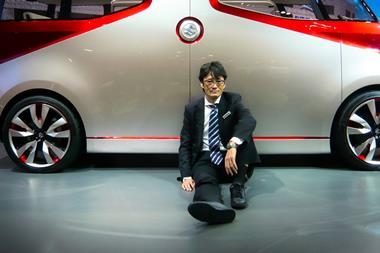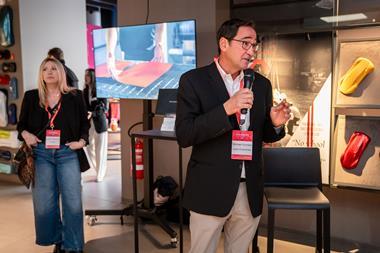Cars – with very rare exceptions – are never designed by one person and rarely even entirely by the company that builds them. Today’s industry is an intricate web of collaborations, suppliers and consultants. But it wasn’t always the case.
Martin Longmore is one of the pioneer consultant designers, working for scores of different companies over the last 30 years. With significant input into the BMW Z3, Audi TT and dozens of motorbikes in his portfolio, he represents the often silent band of contractors who bring their experience to a wide range of varied projects. His most recent work includes the BMW M6 GT3 racecar, BMW-Brilliance Zinoro concept and the Mini E-Scooter.
Growing up in rural south-west Scotland, Longmore knew little of how to become a car designer until a chance meeting between his mother and Ian Callum’s in the mid-1970s cemented the idea that his dream was perhaps achievable. “If you were from the south west of Scotland in a rural community you basically had no real contact or information of how to get into car design. That is why I have a lot to thank Ian for,” he explains.
Four years at Newcastle Polytechnic [now Northumbria University] studying industrial design from 1976 set the foundations of a fascinating career that runs in the family – his brother Chris Longmore is the director and founder of Drive Automotive Design while his son, Daniel Kafka, is a designer in Jaguar’s advanced studio. We caught up with Martin, now based in Germany, to understand more about the untold story of the silent designers.

In the mid-1970s car design education was in its infancy. How did you decide which route to take?
At Newcastle Polytechnic, the ‘Design for Industry’ course didn’t have a transportation aspect, being product design-oriented, but two tutors were instrumental with assisting me with car design – John Elliot and John Sweeney [later the founder of the college’s Transportation Design course and now professor at Pforzheim University]. I tended to try and swing all my projects around to something automotive and so another lecturer, the late Tom Sutcliffe, encouraged me to apply for a competition called ‘Car Design for the 1990s’, by the Royal Society of Arts. I was a finalist and Pinky Lai, who was at the Royal College of Art, was the winner. The other finalist was Moray Callum, Ian’s younger brother [now Ford design VP]. Being a finalist helped a lot because I wasn’t sure if I was good enough to get into the RCA. But I submitted my portfolio, got accepted for 1980 and was also sponsored by Ford Motor Company.
Being sponsored by Ford meant that during my holidays I had the possibility to go to their Dunton studios. I remember walking in there and it just blew me away – being in a professional design studio was really something. I guess at that stage I felt like I had really arrived.
Around this time designers like Gandini and Giugiaro were very much in their heyday. Did they have any influence on you?
One of the stipulations in the Royal Society of Arts competition was to present an idea of what you would do with the prize money. I proposed a trip to Italy to visit the carrozzeria – Bertone, Pininfarina and Giugiaro – and that’s what I did in the summer of 1979. I met the Zagato family and at Bertone I sat in the Stratos Zero, Gandini’s show car. I met Giugiaro and was taken by his right-hand man to look at their models. That was a big step forward and it opened my eyes; I saw the reality of the studios I’d previously only read about or seen pictures of.
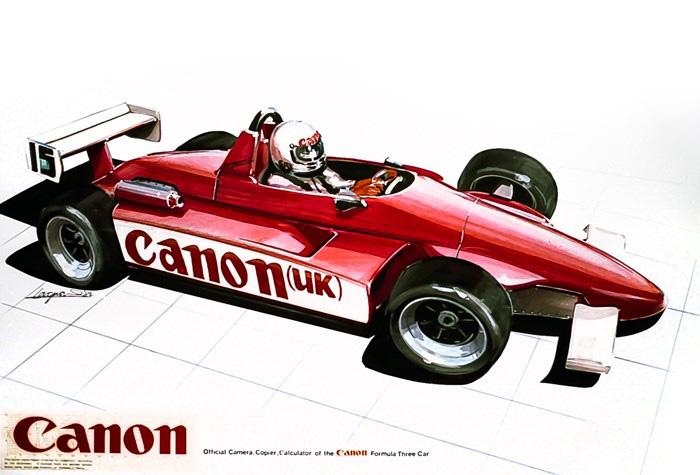
Alongside his car design career, Longmore was racing in (and designing his car's livery for) the British Formula 3 Championship
How was the reality of starting your working life?
When I arrived at Ford as an employee in 1982 I felt that it wasn’t quite as progressive as I had hoped. I felt like maybe there was something else I should be looking at.
In early 1983 I saw an article about International Automotive Design [IAD] in the Financial Times. I kept the cutting and thought: ‘I have got to give this a go.’ I called them up and I was invited down to meet the founder, John Shute. He offered me a job on the spot. He just asked me how much I earned at Ford and then offered me more. They were in effect like an Italian design house in Britain. Within a few months I went to Sweden as a consultant designer at Volvo. I didn’t know anything about the world of consultant design work and IAD were amongst the first, certainly in Britain, to supply designers.
What is it about consulting that appealed to you then and obviously still appeals to you now?
I would say it’s the variety of projects. Some actors get pigeonholed to act in the same role their whole life, others have a wider repertoire. I like to think of myself as having a wider repertoire; an ability to see the bigger picture.
In the beginning it was unusual to have a consultant designer. Sometimes studios need this to get more varied solutions to a design project because their time restraints just don’t allow it. A lot of the larger design studios aren’t effective with their time because there is so much bureaucracy.
In some respects you are a bit like a hitman. There is a bit of risk and that is an appealing aspect. Naturally, the opportunity to be an integral part of a contributing design team is very satisfying.

With the 1986 IAD Alien concept
How did the IAD concept cars come about?
They wanted to put IAD on the global design map so they threw an offer in to all the designers – ‘Come up with something special for a show car.’ In my case I had this idea for what became the IAD Alien.
This show car concept was at the time revolutionary in form and function, and at the Turin Auto Salon in 1986 the experience of unveiling my design to massive accolades from both the automotive and design industry was a dream come true.
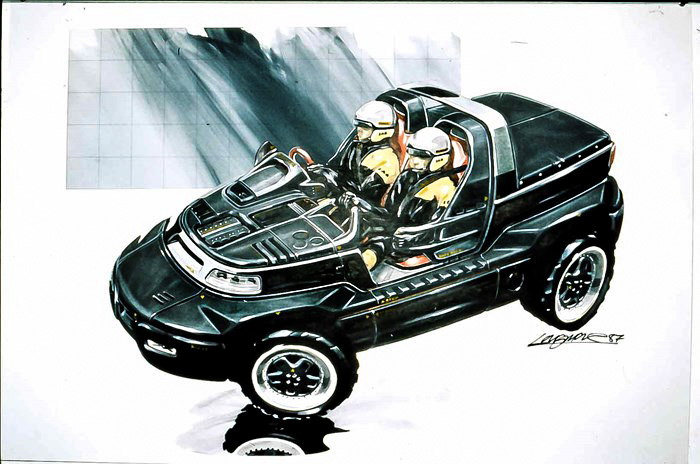
Render of the later IAD Hunter concept
After that show I was also able to visit Marcello Gandini at his home through Giancarlo Perini, the editor of Car Styling magazine. Gandini is a most self-effacing man and really interesting. Almost introverted. I thought, ‘How on earth has he come up with all of this stuff?’
That design was the breakthrough in terms of a global design platform for me. It put IAD really on an equal footing in terms of design and global acceptance and also for myself it established my reputation.
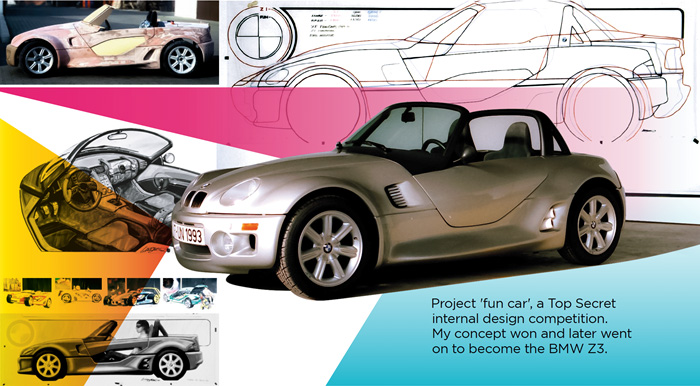
BMW Fun Car that was developed into the Z3
How did you end up settling in Germany?
In 1989 I went to the IAD studio for a meeting about a new role as a manager and as I walked into the studio there was a call from BMW. I came over to Munich and I made some concept sketches for a car but within the motorcycle group. It what was called the Fun Car Project at that stage. It was a competition between all the BMW studios – motorsport, in-house car studios and motorcycle group – to propose a car that would replace the Z1 sports car. The car I proposed within the motorcycle studio actually won and went on to become the Z3.
It’s interesting that it came from the motorcycle studio – was it in any way related to 'bikes?
The concept was quite interesting because it was all to do with this ‘fun car’ idea. It was like a little two-seater SUV and we had all these parts with the hard top, soft top, the pickup rear deck with the ski box container and the extra luggage space – a lot of motorcycle ideas like panniers, so that there was a relevance of the motorcycle in this car.
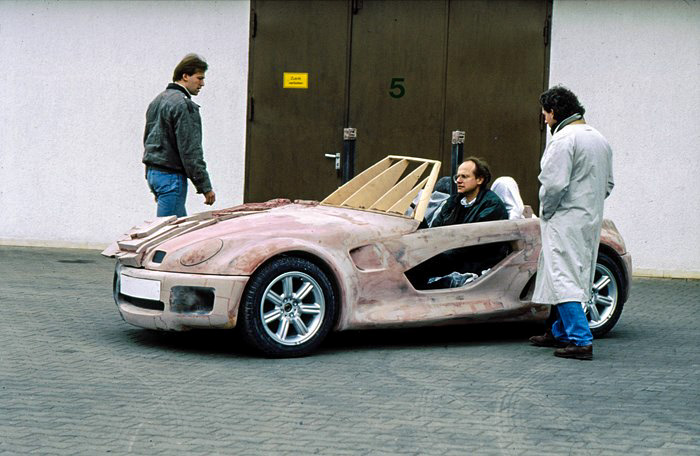
Longmore (right) looks on as the Fun Car takes shape
It was really exciting for me to be head-to-head with all of these guys. It was also very secretive and nobody was to know there was an external designer working on that stuff, especially not Claus Luthe, then BMW chief of design. The model review was in the presentation hall – it was like going into something out of a Bond movie. It was right in the centre of the building at the top of what was called the Penthouse. There is a vast viewing area on top of the studios, all in grey slate, with five turntables and a massive wall at the end they could impose any type of background they wanted. There was also a little road that went out of that presentation hall so you could push models out and around like on a street. I suppose after the initial shock of walking into the Ford studio this was the second really major design-related impression on me.
I was secretly brought in through the back entrance in overalls to help push the model into the showroom and set it up so nobody would know who I was. The guys at Motorrad wanted that at least I saw a part of the presentation. As we pushed that car in and then took the cover off it was like Scotland had put in three against Germany, it was just a complete shock to the designers from the car studios.
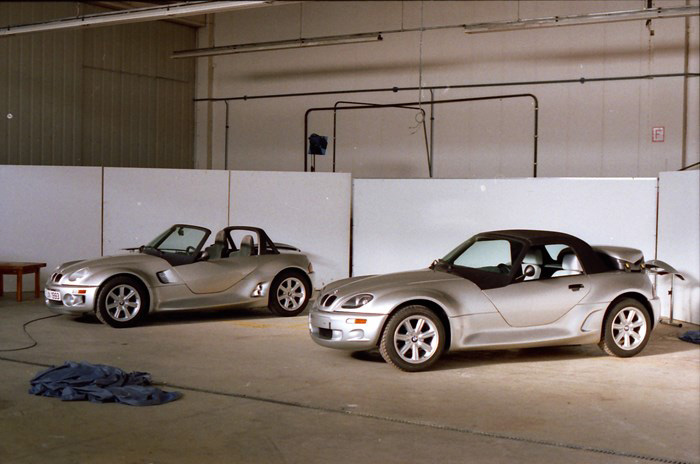
Finished Fun Car presentation models
It seems strange that you weren’t given any recognition even internally. How did that feel?
At the time you do feel a little bit disappointed but what can you say? Personally if I was the head of a studio I would handle it differently. In those days they were very protective – they didn’t like the idea of individual designers getting bigger than the company or other designers within a studio. Now I think designers or creators of projects are given a little bit more recognition than they used to be.
Did you have a similar experience with the Audi TT project?
What is funny is that I went from finishing at BMW, where I just made what would become the Z3, and six months later I was working on what became the TT for Audi. I think I can say that I am the only person in the world who was on two German sports cars that basically came out around the same time for different companies!

How did the project come to be?
I was at Audi in the middle of ‘93 and one of the first projects was some concept ideas for a coupé based on an A6 platform. Five or six of us made some proposals, including Laurens van den Acker [now Renault senior vice president of design]. They liked all my proposals and I had this form with the emphasis on the wheels, the solid bodyside, quite austere and geometric with a typical coupé screen and fastback. I had also done some other sketch work including a couple of light racecar versions that were up on the wall in the studio.

At this time J Mays was the chief designer and had just done the new Beetle project in the California studio with his team of guys including Freeman Thomas [now Ford’s strategic design director]. Over a year after our initial concept proposals, at the end of October 1994, Freeman Thomas came to the studio and asked “Martin what are you doing right now?” This will make you laugh but I was actually designing a wiper blade! “We have got a little project going on, would you be interested to join it?” I said, “I am just working on this unbelievably complicated wiper blade, so it will be hard to drag me away but I will have to think about it!” I came back after lunch and there is a note on my desk from Freeman and it said: ‘Martin you are on the project as of today. Get your stuff and come down.’ So I got my pens, put everything in my bag and I went.
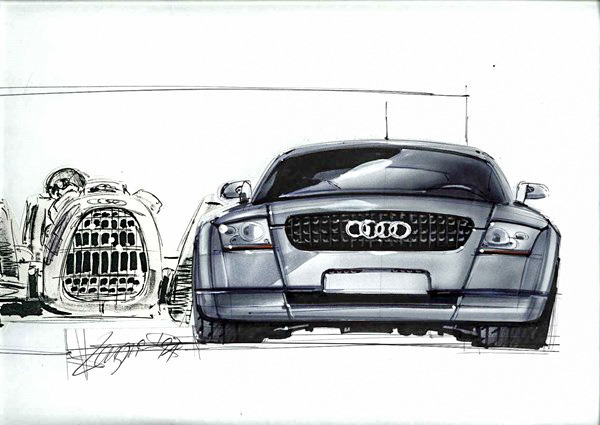
I was brought in and shown this clay model which was the early model for the TT. Freeman said, “We need to get this thing developed.” As he put it, it had bombed the first presentation as it was right at the beginning, having just come from being a quarter-scale. It needed a lot of work and the big next presentation was in six weeks. I was basically running the exterior design as there were lots of other projects running, as well as a change of design head – Mays resigned, Peter Schreyer promoted in his place, and Thomas was gone for long periods back to the US.
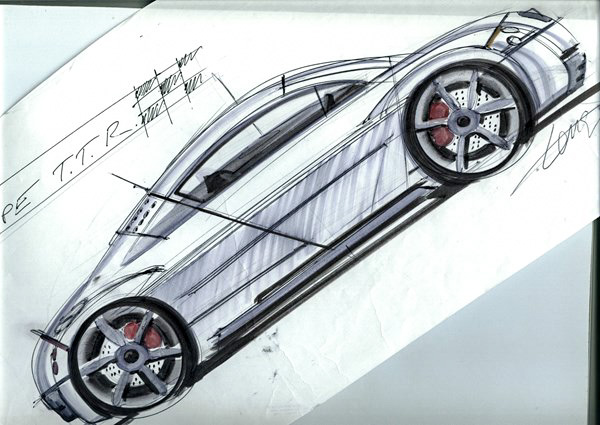
I guided that design through, developed its Teutonic form and brought in things like the egg-crate, allen screw detailed grille, front and rear light graphics and the form’s symmetry. Also the TT cabriolet was designed almost simultaneously – we just chopped off the coupé clay model’s roof and reworked the surfaces and some details. I worked on the interior too, which was lagging behind. It got to the point where the model was presented to the senior Audi bosses and was approved early in 1995.

Did you know that it was going to be something special at the time?
If I remember right it was on a Sunday in Ingolstadt, secretly brought out of the studio into the viewing area and it was actually snowing. This was the first time we had seen it outside and it did look amazing. The project just seemed to gather momentum as good projects usually do – they have their own life. It is something you get to recognise.
At that viewing Dr Paefgen, then head of Audi, asked me to tape up an alternative, typical Audi coupé side window graphic for him, which he liked and said: “That is to be the production car, and the small window option for the show car’, his intention being to deceive the press about the final design solution.
The car was then taken as a hard model to Italdesign. Audi had asked them to make a new set of panels for one of the Auto Union race cars of the '30s and they agreed some sort of package whereby they built the TT show car too. I went down to Turin with the hard model and that was my last involvement with it.
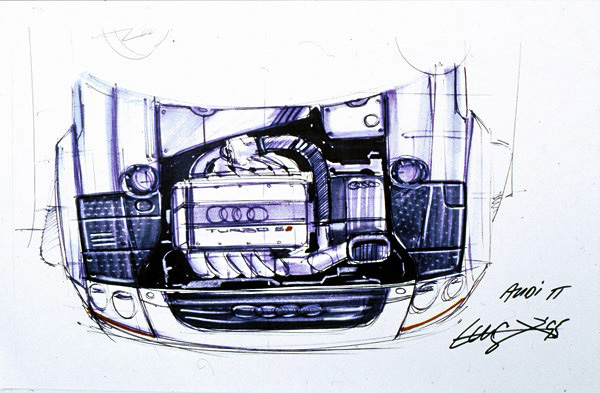
How did it feel to once again not be given recognition for your input to such a landmark design?
It did surprise me and disappoint me, I have to say that. I believe one should always give and receive credit where it’s due, and it’s very dishonest to assume recognition for work you haven’t done. This is a fundamental question of personal integrity.
But you have to look at the whole picture – there were a couple of guys within the studio that developed these show cars for production and when you compare the two there are of course subtle differences in the form and in the detailing. That was totally under Peter Schreyer [who became head of Audi design during the early stages of the programme], so where do you draw the line?

Render of the BMW 650 Funduro
After this your career took a shift towards motorcycle design – how is this different to designing cars?
Motorcycle is almost more an interior type of design work – it’s an interesting mixture. When people ask me, “What do you prefer?” my answer is that I just find it is the challenge of design that is the interesting part.
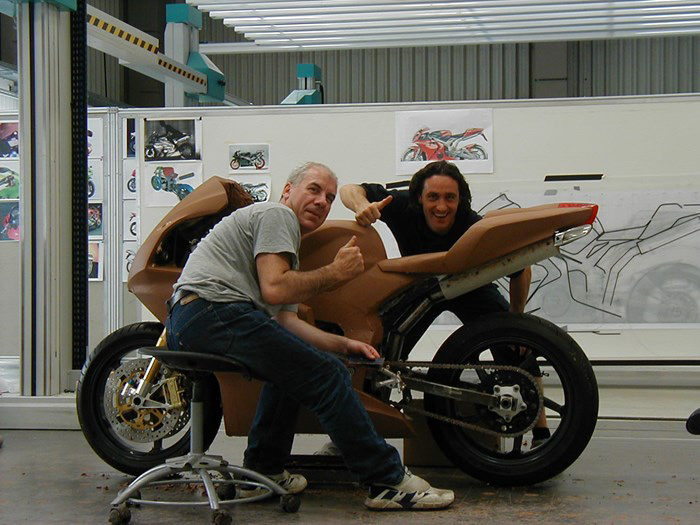
Working on an Aprilia clay model during his 10-year stint at the company
One of the projects I worked on at BMW in between the Fun Car was an entry-level motorcycle that became the BMW 650 Funduro and it immediately became a huge seller. So after my stint at Audi, Aprilia approached me because they wanted to get the same sort of results with some of their products. That lasted the best part of 10 years and worked out very well.

Mini E-Scooter project one of his many two-wheeled designs
And most recently you designed the BMW M6 GT3 racecar. Is there crossover between 'bikes, racing cars and your racing experience?
That project was really interesting – a very compressed timeframe and I was in the wind tunnel with it with the BMW Motorsport engineers and the aerodynamicists – really interesting. My first racing car design was in Derek Palmer's Lotus Elan 26R in 1975. We reworked the aerodynamics with spoilers and a rear wing and actually I applied the same principles some 40 years later to the M6 GT3!
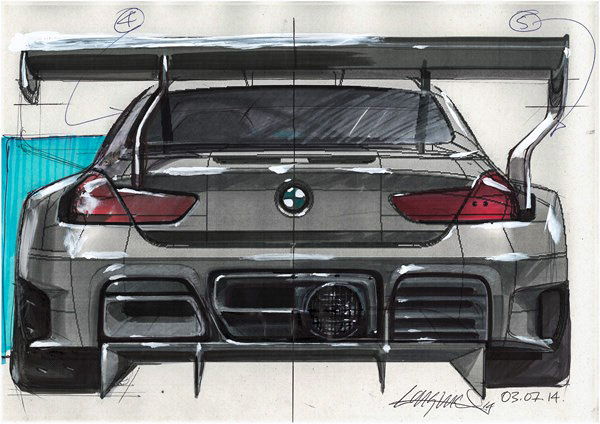
Alternative wing designs for the BMW M6 GT3
I suppose from BMW’s point of view they approached me because they know I get things done and also a little bit for my racing background. I started karts at 10, by 17 graduated to Formula Ford and ultimately Formula 3, aged 23 where I competed against drivers including Nigel Mansell and Ayrton Senna.
How easy is it to find work now, considering how many freelance designers there are?
Right now things are quite difficult – the work is definitely not as forthcoming as it once was. I don’t see it solely due to the increase in freelance designers, it’s actually more to do with major companies themselves – their internal politics, financial resources, requirements and to an extent even limitations of their particular legal restraints.
Most car design studios today attempt everything in-house. If projects are given out, they are as complete projects to design groups, economics usually deciding the recipient. This is perhaps explains the fascination and development of the new electric car companies. There are little or no preconceived attitudes, only a requirement that design innovation is what will market these vehicles.
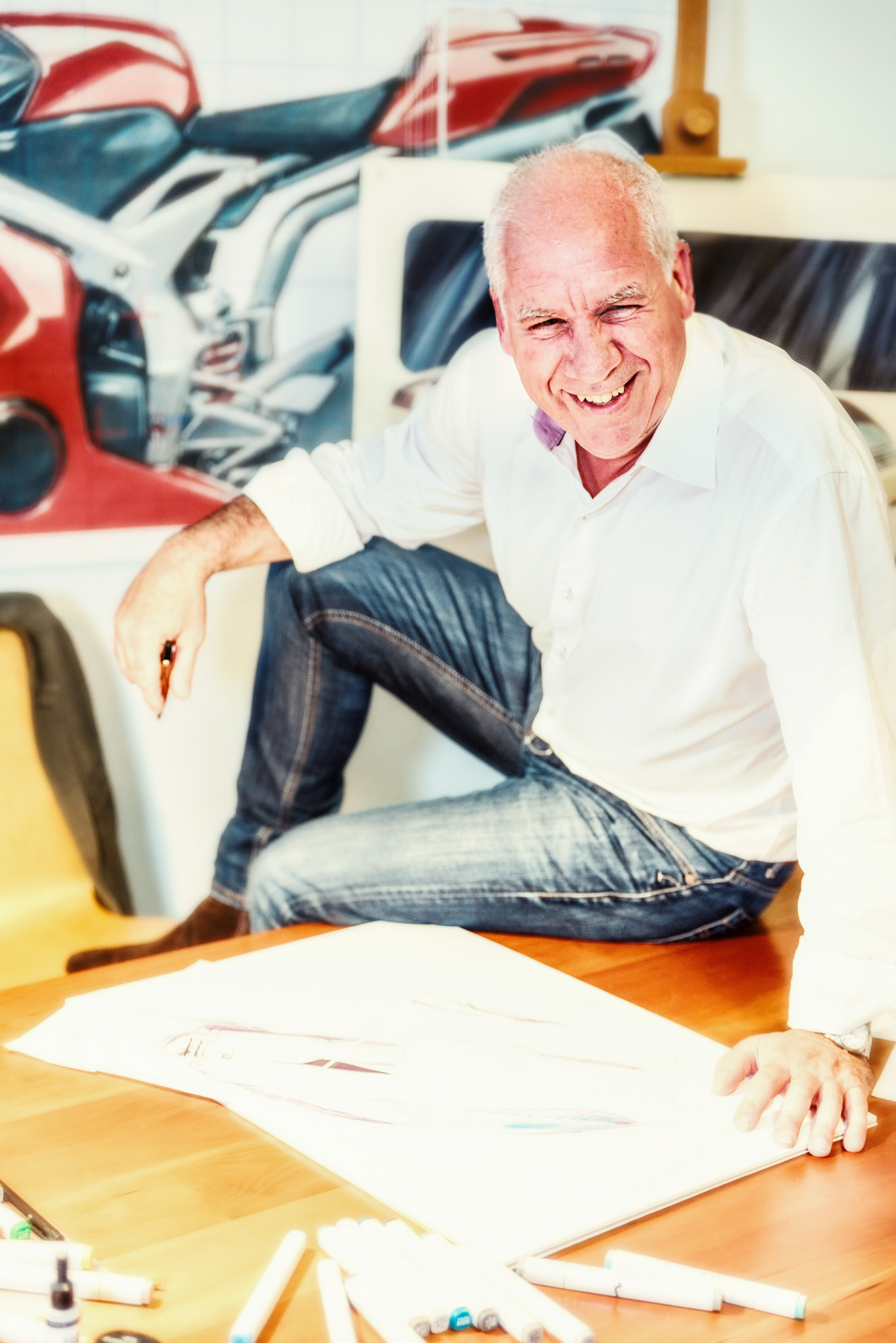
Why do you think things have slowed down?
The society that we live in today puts a huge emphasis on youth which is interesting because those with the most disposable income and actually the most radical tastes are the older generation. And I still feel creative, I still feel active and I am still excited about design – I have a passion for design and creating that I don’t think goes away with age. A pen is a pen and a scalpel is a scalpel. If you don’t know how to operate these things then you are in a mess.
When you look back on your career so far how do you feel?
I have been especially fortunate with how all aspects my life and design career have gone. To misquote Abraham Lincoln: I never had a plan; I have just tried to do my very best each and every day.
More of Martin's work can be found on his website martinlongmore.com































